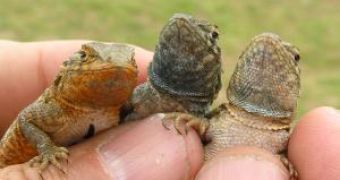If your white wife gives birth to a Black child in Africa or a Mongoloid one in China, you wouldn't be very pleased.
But there are mothers that change the coloration of their offspring according to the local environment.
A team at the University of California, Santa Cruz, has discovered that female side-blotched lizards, in western US, can change life color patterns in their offspring in response to forecast conditions they will face as adults.
Varying the hormone estradiol into their eggs, the lizard females deliver either lengthwise stripes down their backs or bars stretching from side to side, linked to genes for other characteristics. "This is the first example in which exposure to the mother's hormones changes such a fundamental aspect of appearance. Even more exciting is that the mother has different patterns at her disposal, so she can ensure a good match between back patterns and other traits that her offspring possess," said first-author Lesley Lancaster, a UCSC graduate student.
"The lizards' main predator, the coachwhip snake, is a highly efficient hunter, and the lizards need just the right combination of traits to avoid being eaten. The females are dressing their progeny for success, because they need a different back pattern in different conditions," said coauthor Barry Sinervo, professor of ecology and evolutionary biology.
Throat color in side-blotched lizards is linked to their behavior: orange-throated males are highly aggressive and territorial, chasing away other lizards; yellow-throated males sneak into the territories of other males searching for females; and blue-throated males form bonds and cooperate to defend their territories.
In females, throat color is linked to different reproductive strategies. "Females use social cues to predict the circumstances their progeny will encounter. Maternal influences like this probably occur in many species, but are very difficult to detect. You know there are genes for these traits, and it's really hard to tell the maternal effects apart from the effects of the genes," said Sinervo.
Lancaster detected a wide variation of estradiol levels in the yolk of eggs taken from the wild. The team put in breeding enclosure groups made of one male and three female lizards. The ratios of orange- and yellow-throated females in each enclosure were varied, while the throat colors of the males were chosen randomly.
The back pattern of the lizards fits their behavior. The yellow-throated males hide in the grass and a barred pattern breaks up their body outline, matching the background. The orange males stay a lot in the open and the stripes help in this case (they induce an optical effect while moving fast, fact which makes the males quite hard to catch).
But genes behind behavior and back pattern are not connected, and a mismatch renders the individual highly vulnerable to predators. Females solve this problem in 2 ways: they raise the estradiol levels in their eggs when their mate had a yellow throat, producing a barred back pattern in yellow-throated offspring. The barred pattern did not appear in non-yellow offspring.
The other way is by using the hormone to produce extra orange-throated lizards in the female's social environment. In orange-throated males, the hormone led to a striped back pattern but also in non-orange daughters.
Both of these effects were inhibited by yellow genes. "Females provide an estradiol-rich prenatal environment to their entire clutch, but different progeny respond to it in different ways depending on which genes they inherit for throat color. So a female could make some progeny barred and others from the same clutch striped, depending on what's best for each individual." said Lancaster. "The females are responding to cues that predict something about the future environment, but we're not sure yet exactly what that is. Orange-throated neighbors may indicate a trend in the frequency of orange-throated lizards within the population or in the overall population density", she added.
Sinervo links this to the lizard population density: at high densities, the orange-throated males are fighting more with other lizards, being more vulnerable to predators. The predators will prefer them, neglecting lizards with different patterns.
Lizards whose mothers had changed their back patterns clearly presented a survival advantage. The highest survival percentage was found in yellow-throated lizards of both sexes with barred backs, orange-throated males with striped backs, and blue-throated females with striped backs. "The frequencies of yellow and orange were both increasing in the wild that year, so the females exposed to orange neighbors and yellow sires in the experiments had the most fit progeny. But under different environments, maybe the progeny that weren't tweaked would have the highest fitness. If these same estradiol-induced types had the highest survival rates in all years, there would be no need for the females to respond to their social environment--they would just always give their eggs estradiol", Lancaster said.
Field research over several generations of lizards would explain more about the hormones' effect.

 14 DAY TRIAL //
14 DAY TRIAL //